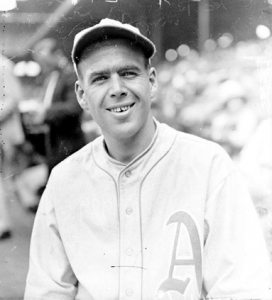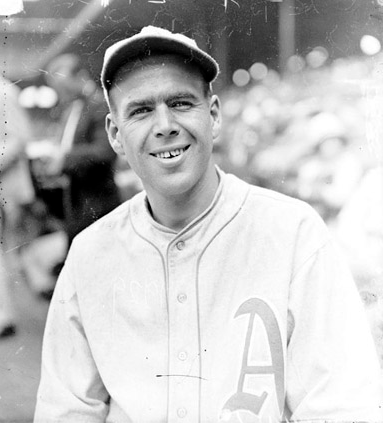October 6, 1931: Earnshaw throws two-hit shutout to even Fall Classic
 Three games into the 1931 World Series, the Philadelphia Athletics’ championship run was in jeopardy. Winners of three consecutive American League pennants from 1929 to 1931, the A’s had defeated the Chicago Cubs, four games to one, in the 1929 World Series, and then topped the St. Louis Cardinals in six games in 1930. Facing the Cardinals again in 1931, the Athletics were looking to become the first major-league team to win the World Series in three consecutive seasons. But after the A’s had taken Game One in St. Louis, 6-2, behind 31-game winner Lefty Grove, the Cardinals had responded with a 2-0 victory in Game Two (behind Bill Hallahan) and a 5-2 victory when the Series moved to Philadelphia for Game Three, with Burleigh Grimes defeating Grove.
Three games into the 1931 World Series, the Philadelphia Athletics’ championship run was in jeopardy. Winners of three consecutive American League pennants from 1929 to 1931, the A’s had defeated the Chicago Cubs, four games to one, in the 1929 World Series, and then topped the St. Louis Cardinals in six games in 1930. Facing the Cardinals again in 1931, the Athletics were looking to become the first major-league team to win the World Series in three consecutive seasons. But after the A’s had taken Game One in St. Louis, 6-2, behind 31-game winner Lefty Grove, the Cardinals had responded with a 2-0 victory in Game Two (behind Bill Hallahan) and a 5-2 victory when the Series moved to Philadelphia for Game Three, with Burleigh Grimes defeating Grove.
A’s manager Connie Mack turned to George Earnshaw in an attempt to avoid falling behind three games to one. In six previous World Series starts, the big (6-foot-4, 210-pound) right-hander known as “Moose” had posted a stellar 1.54 ERA … and he had been particularly good against the Cardinals. In the 1930 Series, Earnshaw had started three times against St. Louis, allowing only two runs in 25 innings (0.72 ERA) and working 22 consecutive scoreless innings from the third inning of Game Two through the eighth inning of Game Six. The A’s had won all three of Earnshaw’s 1930 World Series starts, including the clinching 7-1 victory in Game Six. Though he had lost Game Two of the 1931 Series to Hallahan, Earnshaw permitted only two runs in eight innings. His pitching log for four World Series starts against the Cardinals: a 2-1 record (the A’s had won three of the four games), a 1.09 ERA (four earned runs in 33 innings), and a .164 opponents’ batting average (19-for-116). “We’d heard about Lefty Grove, how hard he could throw,” Cardinals pitcher Burleigh Grimes told Donald Honig. “But I’ll tell you, the guy we thought threw the hardest was Earnshaw. Big George Earnshaw.”1
The Cardinals’ hitting star thus far in the series was center fielder Pepper Martin, a player who had recorded only 14 major-league at-bats prior to the 1931 season. In the loss to Grove in Game One, Martin had gone 3-for-4 and stolen a base. In the Cardinals’ 2-0 Game Two victory against Earnshaw, Martin had scored both of their runs. In the second inning, Martin had doubled, stolen third (“catching the Athletics’ battery flatfooted,” according to James C. Isaminger of the Philadelphia Inquirer) and then raced home on Jimmie Wilson’s fly ball. In the seventh, wrote Isaminger, “Martin put on a real display of dazzling baseball … and had the crowd spellbound.” After leading off the half-inning with a single, he stole second, took third on an infield out, and scored on Charley Gelbert’s squeeze bunt to the mound. According to Isaminger, “George threw poorly to [A’s catcher Mickey] Cochrane, who was pulled slightly out of position.”2 Martin continued to torment the Athletics in St. Louis’s Game Three victory, going 2-for-4 and scoring two of the Cardinals’ five runs.
Martin and Earnshaw offered quite a contrast. According to The Sporting News’ Bill Dooly, Earnshaw’s father was “a shipping prince, owner of a line of freighters that carried the Earnshaw house flag over the briny deep to the farthest corners of the world.” When he first broke into baseball after attending Swarthmore College, wrote Dooly, “Baseball was just a lark to Earnshaw. .”3 Martin, meanwhile, seemed like the perfect symbol of the Great Depression that brought hard times to many Americans in the 1930s. Baseball Hall of Fame historian Lee Allen wrote that the 5-foot-8 Martin had “worked as a newsboy . as a grease monkey in a filling station, as a tinsmith’s helper, and as a diver for lost golf balls in a municipal course.” After turning to baseball, Allen wrote, Martin “would ride the rods to various spring-training camps, pocketing the expense checks that the Cardinals sent him.”4
Game Four of the 1931 World Series featured the second battle between the hobo and the man whose October 1930 Sporting News profile included a photo montage entitled “Born with Silver Spoon in Mouth – Arm of Gold.” Earnshaw’s mound opponent was right-hander Syl Johnson. The A’s got to Johnson quickly; Max Bishop led off the bottom of the first with a single, advanced to second on a Mule Haas sacrifice bunt, moved to third on Mickey Cochrane’s groundout, and scored on a double by Al Simmons. Meanwhile Earnshaw did not allow a hit until Martin singled with one out in the fifth. Martin stole second – his fourth steal of the Series, and his third off Earnshaw – an out later, but Earnshaw struck out Charley Gelbert to end the inning. “Catcher Cochrane was anointed the goat [of the Series] for letting the Wild Horse [Martin] run wild,” wrote Warren Corbett, “but Martin said neither Grove nor Earnshaw knew how to hold baserunners because they didn’t allow many runners.”5
It was still 1-0 with two out in the bottom of the sixth when Jimmie Foxx hit a long home run to left field; Spalding’s Base Ball Guide described the homer a “a prodigious fly over the left field stands, one of the longest hits to that region in the history of the grounds.”6 Bing Miller, the next hitter, doubled to right center, and Jimmy Dykes followed with a single to left to make it 3-0. A single by Dib Williams advanced Dykes to second and finished Johnson, but Cardinals reliever Jim Lindsey struck out Earnshaw to end the inning.
Meanwhile Earnshaw was totally shutting down the Cardinals . except for Martin, whose double leading off the eighth was St. Louis’s second and final hit of the game. St. Louis failed to capitalize, and Earnshaw retired the last six Cardinals to complete his two-hit shutout in 1 hour and 58 minutes. He struck out eight, walked one and faced only 30 hitters. The next morning’s Philadelphia Inquirer included a pitch-by-pitch summary of the game; the author counted 102 pitches from Earnshaw, 74 of them strikes.
Earnshaw’s performance earned praise from all sides. “Earnshaw was superlative,” said Cardinals manager Gabby Street. “I am glad [Burleigh] Grimes pitched yesterday. Had the two boys faced each other the game might have been going yet. He was as perfect as he was in the final tilt last year.”7 In a bylined article, A’s manager Connie Mack wrote that “I have been watching World’s Series since they started … but I do not recall one pitcher who looked as good as George Earnshaw. … It was the most amazing display of heart and skill I have ever seen in a vital game in the years I have been in baseball.”8 In another bylined piece, New York Giants manager John McGraw wrote: “Earnshaw pitched one of the steadiest games I ever saw. In fact he is one of the best world series pitchers the game has ever known. In his cool steadiness he sometimes reminds me of [Christy] Mathewson. Instead of being disturbed, Earnshaw seems to pitch better in a world series game than in the regular season.”9
However, Earnshaw’s victory only knotted the Series at two wins apiece, and McGraw gave the Cardinals the pitching edge going forward, praising “the sound judgment of Gabby Street in holding back [Bill] Hallahan for the next game.”10 And the Cardinals seemed the hungrier team. “If we lose the series,” Earnshaw had said on the morning of Game One, “it will be because our enthusiasm – our drive for more honors – is a bit jaded. … Take my case for instance. After what I did last year anything I do in the future will be an anti-climax. I haven’t the same ambition and enthusiasm to pitch this year that I had last. The additional money – the two thousand dollars that represents the difference between the winner’s and loser’s share of the World’s Series – I can honestly say does not kindle enthusiasm.”11
Ultimately the Series would go the seven-game limit, with Earnshaw facing Burleigh Grimes in the finale at St. Louis’s Sportsman’s Park. Earnshaw pitched respectably, giving up four runs (three earned) and only four hits in seven innings, but the Cardinals prevailed, 4-2. Neither Earnshaw nor Connie Mack’s Philadelphia Athletics ever returned to the World Series.
SOURCES
In addition to the sources cited in the Notes, the author consulted:
Baumgartner, Stan. “Bunts and Pop Flies as Macks Tied Series,” Philadelphia Inquirer, October 7, 1931: 14.
Grauley, S. O. “Can’t Make Meal on ‘Pepper’ Alone and Earnshaw Proves It,” Philadelphia Inquirer, October 7, 1931: 12.
Grauley, S. O. “Pitch by Pitch Dissection Here Reveals Earnshaw’s Hill Genius and Shows How Redbirds Joyous Note Was Stilled,” Philadelphia Inquirer, October 7, 1931: 13.
Isaminger, James B., editor. Reach Official American League Base Ball Guide for 1932 (New York: A.J. Reach, Wright & Ditson, Inc.), 81-106.
Keener, Sid. “Sid Keener’s Column,” St. Louis Star and Times, October 7, 1931: 10.
McCullough, John M. “Yes, Indeed. Very Pleasant Day, Despite That Martin Person, Sole Fly in the A’s Ointment.” Philadelphia Inquirer, October 7, 1931: 6.
Stockton, J. Roy. “Athletics Beat Cards, 3-0, and Tie Series,” St. Louis Post-Dispatch, October 6, 1931: 13.
Wiegand, Harold J. “Earnshaw’s Speed and Macks’ Rally Crush Cards, 3-0,” Philadelphia Inquirer, October 7, 1931″ 1.
baseball-reference.com/postseason/1931_WS.shtml
retrosheet.org/boxesetc/1931/B10060PHA1931.htm
NOTES
1 Donald Honig, The Man in the Dugout (Lincoln: University of Nebraska Press, 1977), 46.
2 James C. Isaminger, “A’s Defeated, 2-0; Hallahan, Martin Put Cards in Race,” Philadelphia Inquirer, October 3, 1931: 1.
3 Bill Dooly, “Earnshaw, World Series Hero, Is Scion of Wealthy New York Family and First Pitched as a Diversion,” The Sporting News, October 16, 1930: 5.
4 Lee Allen, The National League Story: The Official History (New York: Hill & Wang, 1961), 204-05.
5 Warren Corbett, “George Earnshaw,” SABR Bioproject Biography, sabr.org/bioproj/person/4cd6c79e.
6 John B. Foster, editor, Spalding’s Offical Base Ball Guide 1932, 23.
7 Stan Baumgartner, “Redbirds Loud in Praise of Robust Home Run by Foxx,” Philadelphia Inquirer, October 7, 1931: 13.
8 Connie Mack, “Best Hurling I Ever Saw in World’s Series – Connie,” Philadelphia Inquirer, October 7, 1931: 1.
9 John J. McGraw, “Cards Now Have Pitching Edge, Says M’Graw,” St. Louis Post-Dispatch, October 6, 1931: 14.
10 McGraw.
11 Stan Baumgartner, “Ambition to Achieve Win Born in Earnshaw After Connie Has Say,” Philadelphia Inquirer, October 7, 1931: 7.
Additional Stats
Philadelphia Athletics 3
St. Louis Cardinals 0
Game 4, WS
Shibe Park
Philadelphia, PA
Box Score + PBP:
Corrections? Additions?
If you can help us improve this game story, contact us.


